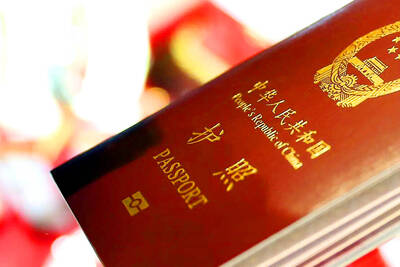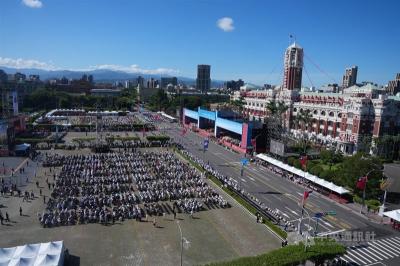The semiconductor ecosystem in Taiwan cannot be replaced or copied, and has a complementary relationship with chip production in the US, American Institute in Taiwan Director Raymond Greene said.
Taiwan need not worry about the so-called “de-Taiwanization of semiconductors,” which some people have expressed concerns about since Taiwan Semiconductor Manufacturing Co (TSMC, 台積電) began building fabs in the US, Greene said during an interview on the YouTube program Mindi World News aired yesterday.
Greene said that some people have misunderstood the industry relationship between the US and Taiwan, and that the industry is not a “zero-sum game.”

Photo: Bloomberg
“For example, someone may complain that semiconductors are manufactured in Taiwan and that there are few manufacturing plants in the US,” he said.
However, the US is still a world leader in chip design and machinery, and it is not disadvantageous to the US for chips to be manufactured in Taiwan, he said.
“Taiwan is small, but has a very strong supply chain and has advantages including industry talent, so this ecosystem cannot be copied or replaced,” he added.

Photo: Screen grab from Mindi World News’ YouTube channel
However, Taiwan alone cannot meet the increasing demand for semiconductors, especially the expanding demand for semiconductors for artificial intelligence (AI) applications, he said.
Taiwan faces restrictions in terms of land for fab development, electricity supply, labor and water resources, he said.
“What is more, many semiconductor customers require that green energy must be used,” he said, referring to RE100, a global initiative to demand that companies use 100 percent renewable energy for manufacturing.
While the high-end semiconductor industry would not leave Taiwan due to its many advantages, chip manufacturing must be done in more places to meet increasing demand, he said, adding that this was the motivation behind GlobalWafers Co’s (環球晶圓) investment in the US.
This is not because the US is trying to rope the company in, but because the company believes Taiwan’s manufacturing capacity is insufficient to meet demand, he said.
Regarding the issue of the US’ strict export controls, Greene said that China’s development of semiconductors is not to develop its economy, but to help the Chinese People’s Liberation Army build more capable missiles, which would threaten the US, Taiwan and allies.
“Therefore, the US is not focusing on the economy through these controls, but rather on national security,” he said.
“From this perspective, the interests of Taiwan and the US are 100 percent identical,” he added.
The situation could be viewed as an opportunity to strengthen high-tech industrial relations with Europe, Japan and other countries, he added.
Regarding how Taiwan should respond to China’s “gray zone” threats including cognitive operations, Greene said that Taiwan’s continual military reforms and the deployment of the US in the Pacific region are strengthening deterrence capabilities.
Therefore, the possibility of a full-scale war is quite low, but Taiwan should continue to voice its concerns about such threats to the world, he said.
Handling provocations from China requires caution and coordination to avoid misunderstandings that could lead to undesirable consequences, he said.
On the issue of the outcome of the US election, Greene said that regardless of who wins, Taiwan would continue to have cross-party support in the US, and that US policy toward the Asia-Pacific region would not change.

The Ministry of the Interior (MOI) is to tighten rules for candidates running for public office, requiring them to declare that they do not hold a Chinese household registration or passport, and that they possess no other foreign citizenship. The requirement was set out in a draft amendment to the Enforcement Rules of the Public Officials Election and Recall Act (公職人員選舉罷免法 ) released by the ministry on Thursday. Under the proposal, candidates would need to make the declaration when submitting their registration forms, which would be published in the official election bulletin. The move follows the removal of several elected officials who were

The Republic of China (ROC) is celebrating its 114th Double Ten National Day today, featuring military parades and a variety of performances and speeches in front of the Presidential Office in Taipei. The Taiwan Taiko Association opened the celebrations with a 100-drummer performance, including young percussionists. As per tradition, an air force Mirage 2000 fighter jet flew over the Presidential Office as a part of the performance. The Honor Guards of the ROC and its marching band also heralded in a military parade. Students from Taichung's Shin Min High School then followed with a colorful performance using floral imagery to represent Taiwan's alternate name

FOUR DESIGNATED AREAS: Notices were issued for live-fire exercises in waters south and northwest of Penghu, northeast of Keelung and west of Kaohsiung, they said The military is planning three major annual exercises across the army, navy and air force this month, with the navy’s “Hai Chiang” (海強, “Sea Strong”) drills running from today through Thursday, the Ministry of National Defense said yesterday. The Hai Chiang exercise, which is to take place in waters surrounding Taiwan, would feature P-3C Orion maritime patrol aircraft and S-70C anti-submarine helicopters, the ministry said, adding that the drills aim to bolster the nation’s offshore defensive capabilities. China has intensified military and psychological pressure against Taiwan, repeatedly sending warplanes and vessels into areas near the nation’s air defense identification zone and across

COVETED PRIZE: The US president would be a peace prize laureate should he persuade Xi Jinping to abandon military aggression against Taiwan, William Lai said US President Donald Trump should get the Nobel Peace Prize should he be able to convince Chinese President Xi Jinping (習近平) to abandon the use of force against Taiwan, President William Lai (賴清德) told a conservative US radio show and podcast in an interview. The US is Taiwan’s most important international backer, despite the absence of formal ties, but since Trump took office earlier this year he has not announced any new arms sales to the nation. Trump could meet Xi at the APEC summit in South Korea on Oct. 31 and Nov. 1. Lai, speaking on The Clay Travis and Buck Sexton